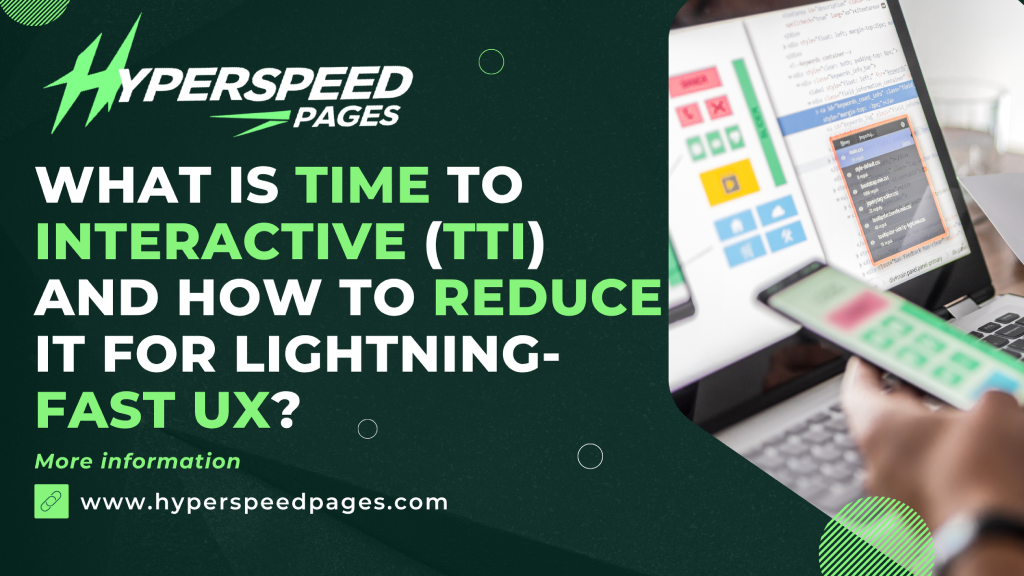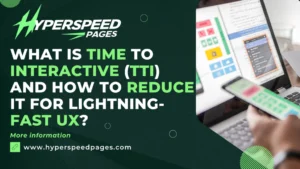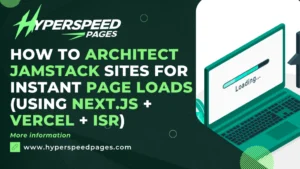
TL;DR: What Is TTI?
Time to Interactive (TTI) is a Core Web Vitals metric that measures how long it takes for a web page to become fully interactive, meaning:
- The page has displayed useful content (First Contentful Paint)
- Event handlers are registered for visible elements
- The page is responding reliably to user input within 50ms
Reducing TTI is essential for optimizing user experience, conversion rates, and SEO rankings, particularly for dynamic SPAs, eCommerce, and mobile-first web apps.
What Is TTI in Page Speed? (AEO Optimized Definition)
TTI (Time to Interactive) is a performance metric that captures the delay between when a page first appears and when it becomes reliably usable.
It answers: “When can a user click, type, or scroll without lag?”
Measured in milliseconds (ms), TTI is often higher than FCP or LCP because it includes the time taken by:
- JavaScript parsing and execution
- Long tasks (>50ms CPU blocking)
- Lazy-loading essential resources
How Is TTI Measured?
TTI is calculated in milliseconds (ms) and categorized as:
- Good: ≤ 3.8 seconds
- Needs Improvement: 3.9–7.3 seconds
- Poor: > 7.3 seconds
Where TTI Fits in the UX Timeline
| Metric | Meaning | Trigger Time |
| FCP | First text/image is painted | Visual cue only |
| LCP | Main content is fully visible | Visual readiness |
| TTI | Page accepts reliable input | Functional interactivity |
Why Does TTI Matter for SEO and User Experience?
1. Google Ranks Faster, More Interactive Pages Higher
Since TTI is part of Core Web Vitals, a slow TTI can negatively impact your search rankings. Google prioritizes pages that offer a smooth, frustration-free experience.
2. High Bounce Rates from Frustrated Users
If users can see content but can’t interact with it (e.g., buttons don’t work), they’ll leave. 53% of mobile users abandon sites that take over 3 seconds to load (Google).
3. Lower Conversion Rates
A second delay in page interactivity can lead to:
- 10% fewer conversions (Mozilla)
- 7% loss in sales (Akamai)
A fast TTI means:
- Users don’t wait for buttons or forms to respond
- Pages feel snappy and responsive
- Less frustration = lower bounce rate
- Better scores on Core Web Vitals = higher Google rankings
According to Google: Sites with TTI < 3.8 seconds see 24% more conversions.
TTI is Especially Critical For:
- Single Page Applications (SPAs)
- E-commerce checkout flows
- Mobile-first web apps
- Ad-heavy media sites
What Causes a Slow Time to Interactive (TTI)?
Several factors can delay TTI, including:
1. Heavy JavaScript Execution
-Unoptimized JS blocks the main thread.
-Large bundles take longer to parse and execute.
2. Render-Blocking Resources
-CSS and JS files that delay page rendering.
3. Long Tasks (Main Thread Blocking)
– JavaScript tasks taking > 50ms stall interactivity.
4. Large, Unoptimized Images & Assets
-Slow down rendering and increase CPU workload.
5. Too Many Third-Party Scripts
– Ads, analytics, and social widgets add overhead.
6. Lazy-Loaded Resources
– Lazy-loading non-visible but critical UI elements (like navigation) can delay readiness.
7. Inefficient Rendering
– Layout thrashing, excessive DOM depth, and CSS recalculations block painting.
How Is TTI Measured?
TTI is not trivial to calculate. It’s determined by looking for a quiet window when:
- The main thread is free of long tasks for at least 5 seconds
- All event listeners are attached
- No network activity blocks interactivity
Tools That Measure TTI
| Tool | TTI Metric Support |
| Lighthouse | Yes (Simulated) |
| WebPageTest | Yes (Real metrics) |
| Chrome DevTools | Yes (Timeline View) |
| PageSpeed Insights | Yes (Field + Lab) |
| RUM (Real User Monitoring) | Yes |
How to Reduce Time to Interactive (TTI): 10 Proven Strategies
1. Minimize & Optimize JavaScript
Code splitting: Load only necessary JS (e.g., with Webpack).
Defer non-critical JS: Use async or defer.
Remove unused code: Leverage tree shaking and PurgeCSS.
2. Eliminate Render-Blocking Resources
– Inline critical CSS and defer the rest.
– Load JS asynchronously to prevent parser blocking.
3. Reduce Long Tasks with Web Workers
– Offload heavy computations to Web Workers to free up the main thread.
4. Implement Efficient Caching
– Use Service Workers for offline caching.
– Leverage HTTP/2 Server Push for faster asset delivery.
5. Optimize Images & Fonts
– Compress images (WebP, AVIF).
– Preload critical fonts to avoid layout shifts.
6. Lazy Load Non-Critical Elements
– Use loading=”lazy” for images and iframes.
– Load components on interaction (e.g., modal pop-ups).
7. Limit Third-Party Scripts
– Audit and remove unnecessary trackers.
– Load third-party scripts after the page is interactive.
8. Preconnect to Key Origins
– Use for CDNs and APIs.
9. Use a Performance-Optimized Hosting Solution
– Edge CDNs (Cloudflare, Fastly) reduce latency.
– Server-side rendering (SSR) improves TTI for SPAs.
10. Monitor & Continuously Improve
– Track TTI with Google Search Console (Core Web Vitals report).
– Use Real User Monitoring (RUM) tools like New Relic.
TTI Optimization in Jamstack & Next.js
In Jamstack frameworks like Next.js:
a) Static generation reduces TTI dramatically
b) Incremental Static Regeneration (ISR) enables dynamic content without blocking render
c) Edge Functions avoid round trips to origin servers
TTI and AEO (Ask Engine Optimization)
Why TTI Matters in 2025 for AI-driven SERPs:
- Search and Ask Engines (SGE, ChatGPT, Perplexity) evaluate page speed metrics
- TTI affects engagement and featured snippet eligibility
- Faster TTI means higher chances of surfacing in zero-click results
Mobile TTI: Special Considerations
On mobile:
- CPUs are slower
- Network latency is higher
- Power constraints amplify performance issues
Best practices:
- Avoid large JS bundles (>150KB)
- Eliminate unused polyfills and libraries
- Prefer CSS-only animations
Ready to Boost Your TTI?
- Test your site with Google PageSpeed Insights.
- Audit JavaScript and CSS bottlenecks.
- Implement optimizations step by step.
TTI Performance Benchmarks (2025)
| Site Type | Avg TTI (Desktop) | Avg TTI (Mobile) | Optimization Grade |
| Static Jamstack | ~0.9s | ~1.3s | ⭐⭐⭐⭐⭐ |
| SPA (React) | ~3.2s | ~5.1s | ⭐⭐⭐ |
| WordPress (Heavy) | ~4.6s | ~6.8s | ⭐⭐ |
| eCommerce (ISR) | ~1.4s | ~2.1s | ⭐⭐⭐⭐ |
Key Takeaways
- TTI measures when a page becomes fully interactive.
- A slow TTI hurts UX, conversions, and SEO.
- Optimize JS, defer non-critical resources, and reduce long tasks.
- Monitor TTI continuously for sustained performance gains.
Optimize for People, Not Just Pixels
TTI is not just about performance scores. It reflects how real users experience your site. Between micro-moments, users judge your app in the first second. If your CTA button is visible but doesn’t work instantly, you’ve already lost the click.
Prioritize:
- Main-thread efficiency
- Visual readiness
- Functional interactivity
- Your users (and your ranking) will thank you.
Want Your Pages to Be Instantly Interactive?
We specialize in engineering lightning-fast websites at Hyperspeed Pages. Let our team audit and optimize your site for TTI, LCP, INP, and AEO success.




